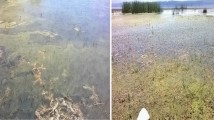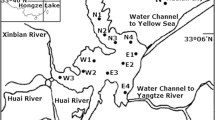Abstract
Purpose
China’s freshwater subtropical shallow lakes are increasingly eutrophic and susceptible to production of heavy growths or water blooms of cyanobacteria. One example was the heavy water bloom that occurred for the first time in Lake Xuanwu, in 2005, an urban lake located in Nanjing city. The aim of the present study was to determine dynamics of water bloom dominating Microcystis in this lake. Meanwhile, the relationship between environmental factors and Microcystis populations was also analyzed.
Materials and methods
Molecular detection, using quantitative polymerase chain reaction, was used in this lake to study the dynamics of the cyanobacterial community, its Microcystis populations, and the microcystin-producing Microcystis genotypes from August 2005 to November 2006.
Results
It was shown that Microcystis wesenbergii and Microcystis aeruginosa were the main components of the cyanobacterial blooms in Lake Xuanwu, and they coexisted with species of the filamentous cyanobacterial genera Anabaena, Planktothrix, and Anabaenopsis. Microcystis cells were detected during the entire survey period and in all sample sites. The cell abundance of Microcystis ranged from 3.6 × 102 cells ml−1 to a peak of 3.8 × 106 cells ml−1. The ratio of mcyB-containing Microcystis subpopulations to the total Microcystis varied, ranging from 0.1% to 12.8%. The abundance of Microcystis containing the mcyB microcystin gene was shown to be significantly correlated with concentrations of total phosphorus and phosphate.
Conclusions
Water temperature was the primary factor affecting Microcystis abundance in the lake, and phosphorus loading was shown to be a main factor in governing the growth of both microcystin-producing genotype and total Microcystis population. Higher Microcystis cell counts at the bottom of the water column before and after appearance of water blooms in Lake Xuanwu suggested that Microcystis numbers in the water column, especially at the bottom of the water column, play an important role in forming the next water bloom.






Similar content being viewed by others
References
Altschul SF, Madden TL, Schaffer AA, Zhang J, Zhang Z, Miller W, Lipman DJ (1997) Gapped BLAST and PSI-BLAST: a new generation of protein database search programs. Nucleic Acids Res 25:3389–3402
Boström B, Pettersson AK, Ahlgren I (1989) Seasonal dynamics of a cyanobacteria-dominated microbial community in surface sediments of a shallow eutrophic lake. Aquat Sci 51:153–178
Brunberg AK, Blomqvist P (2002) Benthic overwintering of Microcystis colonies under different environmental conditions. J Plankton Res 24:1247–1252
Cao HS, Tao Y, Kong FX, Yang Z (2008) Relationship between temperature and cyanobacterial recruitment from sediments in laboratory and field studies. J Freshwater Ecol 23:405–412
Carmichael WW, Azevedo MFO, An JS, Molica RJR, Jochimsen EM, Lau S, Rinehart KL, Shaw GR, Eagelsham GK (2001) Human fatalities from cyanobacteria: chemical and biological evidence for cyanotoxins. Environ Health Persp 109:663–668
Chen YW, Qin BQ, Teubner K, Dokulil MT (2003) Long-term dynamics of phytoplankton assemblages: Microcystis-domination in Lake Taihu, a large shallow lake in China. J Plankton Res 25:445–453
Chorus I, Bartram J (1999) Toxic cyanobacteria in water. A guide to their public health consequences, monitoring and management. E and FN Spon, London
Davis TW, Berry DL, Boyer GL, Gobler CJ (2009) The effects of temperature and nutrients on the growth and dynamics of toxic and non-toxic strain of Microcystis during cyanobacteria blooms. Harmful Algae 8:715–725
Downing TG, Meyer C, Gehringer MM, Venter MVD (2005) Microcystin content of Microcystis aeruginosa is modulated by nitrogen uptake rate relative to specific growth rate or carbon fixation rate. Environ Toxicol 20:257–262
Fan C, Yang X, Shi L, Xu D, Zhang Q, Wu C (2005) Characteristics and cause of lake eutrophication in Jiangsu province with suggestions on its control measures. Resour Environ Yangtze Basin 14:218–223, in Chinese
Hotto AM, Satchwell MF, Boyer GL (2007) Molecular characterization of potential microcystin-producing cyanobacteria in lake Ontario embayments and nearshore waters. Appl Environ Microb 73:4570–4578
Hotto AM, Satchwell MF, Berry DL, Gobler CJ, Boyer GL (2008) Spatial and temporal diversity of microcystins and microcystin-producing genotypes in Oneida Lake, NY. Harmful Algae 7:671–681
Ke Z, Xie P, Guo L (2008) Controlling factors of spring–summer phytoplankton succession in Lake Taihu (Meiliang Bay, China). Hydrobiologia 607:41–49
Kotak BG, Lam AKY, Prepas EE, Hrudey SE (2000) Role of chemical and physical variables in regulating microcystin-LR concentration in phytoplankton of eutrophic lakes. Can J Fish Aquat Sci 57:1584–1593
Kuiper-Goodman T, Falconner I, Fitzgerald J (1999) Human health aspects. In: Chorus I, Bartram J (eds) Toxic cyanobacteria in water: a guide to their public health consequences, monitoring and management. E and FN Spon, London, pp 113–153
Kurmayer R, Kutzenberger T (2003) Application of real-time PCR for quantification of microcystin genotypes in a population of the toxic cyanobacterium Microcystis sp. Appl Environ Microb 69:6723–6730
Kurmayer R, Dittmann E, Fastner J, Chorus I (2002) Diversity of microcystin genes within a population of the toxic cyanobacterium Microcystis spp. in Lake Wannsee (Berlin, Germany). Microb Ecol 43:107–118
Kurmayer R, Christiansen G, Fastner J, Börner T (2004) Abundance of active and inactive microcystin genotypes in populations of the toxic cyanobacterium Planktothrix spp. Environ Microbiol 6:831–841
Lahti K, Rapala J, Färdig M, Niemelä M, Sivonen K (1997) Persistence of cyanobacterial hepatotoxin, microcystin-LR in particulate material and dissolved in lake water. Water Res 31:1005–1012
Li K, Song L, Wang N (2004) Studies on recruitment and growth characteristic of Microcystis in sediment. Acta Hydrobiologica Sin 28:113–118 (in Chinese)
Neilan BA, Jacobs D, Del Dot T, Blackall LL, Hawkins PR, Cox PT, Goodman AE (1997) rRNA sequences and evolutionary relationships among toxic and nontoxic cyanobacteria of the genus Microcystis. Int J Syst Bacteriol 47:693–697
Nübel U, Garcia-Pichel F, Muyzer G (1997) PCR primers to amplify 16S rRNA genes from cyanobacteria. Appl Environ Microbiol 63:3327–3332
Oh H, Lee SJ, Jang M, Yoon B (2000) Microcystin production by Microcystis aeruginosa in a phosphorus limited chemostat. Appl Environ Microbiol 66:176–179
Paerl HW, Fulton RS, Moisander PH, Dyble J (2001) Harmful freshwater algal blooms, with an emphasis on cyanobacterial. Scientific World Journal 1:76–113
Philipp R, Rowland MGM, Baxter PJ, McKenzie C, Bell RH (1991) Health risks from exposure to algae. CDR (London: England Rev) 1:R67–R68
Preston T, Stewart WDP, Reynolds CS (1980) Bloom-forming cyanobacterium Microcystis aeruginosa overwinters on sediment surface. Nature 288:365–367
Rantala A, Rajaniemi-Wacklin P, Lyra C, Lepisto L, Rintala J, Mankiewiez-Boczek J, Sivonen K (2006) Detection of microcystin-producing cyanobacteria in Finnish lakes with genus-specific microcystin synthetase gene E (mcyE) PCR and associations with environmental factors. Appl Environ Microbiol 72:6101–6110
Rapala J, Sivonen K (1998) Assessment of environmental conditions that favor hepatotoxic and neurotoxie Anabaena spp. strains cultured under light limitation at different temperature. Microb Ecol 36:181–192
Reynolds CS, Jaworski GHM, Cmiech HA, Leedale GF (1981) On the annual cycle of the blue-green algae Microcystis aeruginosa Kütz. Emend. Elenkin. Philos T Roy Soc B 293:419–477
Rinta-Kanto JM, Ouellette AJA, Boyer GL, Twiss MR, Bridgeman TB, Wilhelm SW (2005) Quantification of toxic Microcystis spp. during the 2003 and 2004 blooms in western Lake Erie using quantitative real-time PCR. Environ Sci Technol 39:4198–4205
Rinta-Kanto JM, Konopko EA, Debruyn JM, Bourbonniere RA, Boyer GL, Wilhelm SW (2009) Lake Erie Microcystis: relationship between microcystin production, dynamics of genotypes and environmental parameters in a large lake. Harmful Algae 8:665–673
Robarts RD, Zohary T (1987) Temperature effects on photosynthetic capacity, respiration, and growth rates of bloom-forming cyanobacteria. New Zeal J Mar Fresh 21:391–399
Song L, Chen W, Peng L, Wan N, Gan N, Zhang X (2007) Distribution and bioaccumulation of microcystins in water columns: a systematic investigation into the environmental fate and the risks associated with microcystins in Meiliang Bay, Lake Taihu. Water Res 41:2853–2864
Utkilen H, Gjolme N (1995) Iron-stimulated toxin production in Microcystis aeruginosa. Appl Environ Microbiol 61:797–800
Vaitomaa J, Rantala A, Halinen K, Rouhiainen L, Tallberg P, Mokelke L, Sivonen K (2003) Quantitative real-time PCR for determination of microcystin synthetase E copy numbers for Microcystis and Anabaena in lakes. Appl Environ Microbiol 69:7289–7297
Verspagen JMH, Snelder EOFM, Visser PM, Huisman J, Mur LR, Ibelings BW (2004) Recruitment of benthic Microcystis (Cyanophyceae) to the water column: internal buoyancy changes or resuspension? J Phycol 40:260–270
Vézie C, Rapala J, Vaitomaa J, Seitsonen J, Sivonen K (2002) Effect of nitrogen and phosphorus on growth of toxic and nontoxic Microcystis strains and on intracellular microcystin concentrations. Microb Ecol 43:443–454
Visser PM, Ibelings BW, Mur LR (1995) Autumnal sedimentation of Microcystis spp. as result of an increase in carbohydrate ballast at reduced temperature. J Plankton Res 17:919–933
Wang Y, Li J, Wu M, Wang Y, Weng Y (2007) Composition of Microcystis species of the cyanobacterial bloom in xuanwu lake of Nanjing. Environ Sci 28:2187–2191 (in Chinese)
Wicks RJ, Thiel PG (1990) Environmental factors affecting the production of peptide toxins in floating scums of the cyanobacterium Microcystis aeruginosa in a hypertrophic African reservoir. Environ Sci Technol 24:1413–1418
Xu Y, Wu Z, Yu B, Peng X, Yu G, Wei Z, Wang G, Li R (2008) Non-microcystin producing Microcystis wesenbergii (Komárek) Komárek (Cyanobacteria) representing a main waterbloom forming species in Chinese waters. Environ Pollut 156:162–167
Yoshida M, Yoshida T, Takashima Y, Hosoda N, Hiroishi S (2007) Dynamics of microcystin-producing and non-microcystin-producing Microcystis populations is correlated with nitrate concentration in a Japanese lake. FEMS Microbiol Lett 266:49–53
Yoshida M, Yoshida T, Kashima A, Takashima Y, Hosoda N, Nagasaki K, Hiroishi S (2008) Ecological dynamics of the toxic bloom-forming cyanobacterium Microcystis aeruginosa and its cyanophages in Freshwater. Appl Environ Microbiol 74:3269–3273
Zhang ZS, Huang XF (1991) A manual on methods for plankton research in freshwater. Science Press, Beijing, pp 333–356
Zhang X, Kong F, Cao H, Tan J, Tao Y, Wang M (2005) Recruitment dynamics of bloom-forming cyanobacteria in Meiliang Bay of Taihu Lake. Chinese J Appl Ecol 16:1346–1350 (in Chinese)
Zheng X, Xiao L, Ren J, Yang L (2008) Variation of bacterial community in the outbreak and decline of Microcystis spp. bloom in Lake Xuanwu. Environ Sci 29:2956–2962 (in Chinese)
Author information
Authors and Affiliations
Corresponding author
Additional information
Responsible editor: Hailong Wang
Electronic supplementary material
Below is the link to the electronic supplementary material.
Fig. 1
The proportions of cyanobacterial species during water bloom season and after bloom in Lake Xuanwu 2005–2006 (DOC 23 kb)
Rights and permissions
About this article
Cite this article
Xu, Y., Wang, G., Yang, W. et al. Dynamics of the water bloom-forming Microcystis and its relationship with physicochemical factors in Lake Xuanwu (China). Environ Sci Pollut Res 17, 1581–1590 (2010). https://doi.org/10.1007/s11356-010-0345-8
Received:
Accepted:
Published:
Issue Date:
DOI: https://doi.org/10.1007/s11356-010-0345-8




